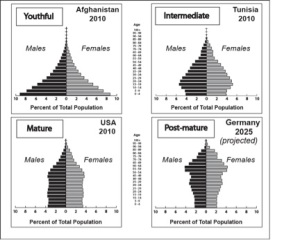[Population Aging to 2030, Day 4, Essay 1 of 2]
Unprecedented demographic decline promises to lead Tokyo into uncharted economic, social, environmental, and diplomatic territory in the coming decades. Owing to low fertility, high life expectancy, and trifling immigration, Japan will be significantly older and smaller in 2030 than it is today. The population will decline from 128 million in 2010 to 116 million twenty years hence, averaging a loss of over 660,000 Japanese citizens per year. During this same period, Japan’s working age population (ages 15-64) will shrink by 17 percent from 81 million to 67 million. The median age of the population will rise from 45 to 50 while about a third of the population will be over 65 years old by 2030.
The diminishing work force will almost certainly limit the prospects for robust economic growth. A graying society, meanwhile, will impose potentially overwhelming financial burdens on the polity to care for the elderly. Beyond the socioeconomic challenges, depopulation and aging will also have worrisome implications for Japan’s national security. As the population ages and shrinks at accelerating rates, Tokyo will be increasingly hard pressed to fulfill basic military obligations ranging from homeland defense to the discharge of international responsibilities. Indeed, a sharp mismatch between its strategic posture and resources looms.
For the past decade, successive administrations have deployed ground, air, and naval forces far beyond Japan’s own neighborhood to conduct “international peace cooperation operations,” a vague umbrella term that includes humanitarian assistance, disaster relief, and reconstruction activities. At the same time, pressures closer to home, including China’s rise and North Korea’s unpredictability, continue to consume policy attention. Yet, Japan’s proliferating security challenges are already bumping up against a manpower ceiling, potentially stifling its quiet ambitions.
The figures are sobering. The male population eligible to join Japan’s Self-Defense Forces (aged 18 to 26) peaked at nine million in 1994. In just over fifteen years, this age group recorded an astounding 30 percent drop, plummeting to around six million. By 2030, eligible males will fall to less than five million. By contrast, the United States will casino online post a 16 percent increase for the same cohort between 2010 and 2030.
Manpower constraints are already having a telling effect on force structure. Faced with new missions even as personnel levels remained fixed, Japan’s maritime service was compelled to siphon servicemen from frontline and support units to fulfill additional duties. Consequently, crews on some ships became shorthanded by as much as 30 percent. This in turn forced the transfer of sailors from warships decommissioned well ahead of schedule to replenish undermanned vessels in the fleet.
Recent defense policy documents have held out hope that technology will substitute for people, potentially easing personnel shortages. But most military operations—ranging from high-end conventional wars to post-conflict reconstruction—soak up manpower. Gee-whiz technologies, such as unmanned systems, only go so far. War fighters in the field and support crews in the rear must still do much of the heavy lifting.
Japan’s response to the March 2011 tsunami disaster was the starkest reminder of this reality: Tokyo called up over 100,000 military personnel—about 40 percent of the active duty force—for relief operations, the largest deployment of troops in Japan’s postwar history. In short, boots on the ground still count for much in peacetime as casino in war.
Unless Japan is prepared for a major military buildup, which appears politically doubtful and fiscally unsustainable, the country’s shrinking pool of manpower will weigh heavily on Japanese decision makers. Tokyo’s bold claim that it will actively promote international peace and security while bolstering its independent capacity to defend itself strains credulity.
Several implications are discernible from the projected population trends. First, Japan cannot do it all. Japanese leaders must set clearer priorities—in effect establishing a hierarchy among traditional war-fighting tasks and the nontraditional tasks Tokyo anticipates. They must also consider the strategic, operational, and force-structure trade-offs of any priorities they choose to set. Do, say, humanitarian missions outweigh sea-lane defense? Perhaps a starker choice awaits Tokyo. Japan may have to favor manpower-intensive conventional operations that match China’s growing military prowess in East Asia while foregoing international peacekeeping missions.
Second, Japan will likely rely even more on the United States for its security. In the worst case scenario, overdependence on Washington could tempt Japanese policymakers to hand off ever more defense responsibilities to the U.S. military, hollowing out the Self-Defense Forces. The corollary is that the depopulating nation may become less willing and able than it has been for the past six decades to help the United States defend the liberal international order. The larger question for Washington, then, is how it can adjust to an emerging security paradigm in which a key strategic anchor in Asia recedes from the world scene.
Finally, an analytical caveat is warranted. Strategic axioms that have long guided Japanese security strategy, such as the informal cap on the defense budget, could undergo radical change in times of severe duress. A violent or peaceful unification of the Korean Peninsula that produced a state hostile to Tokyo or a Sino-Japanese naval war over disputed maritime claims could trigger a fundamental reassessment and reorientation. While population decline will clearly limit the range of Japanese policy options, there is nothing fated about Japan’s self-imposed restraints. The role of contingency in international politics will thus remain an ever active ingredient to Japanese strategic choices.
Nevertheless, the population crisis for Japan is undoubtedly approaching, and this crunch will be accompanied by unprecedented pressures and demands. The anguishing decisions to mitigate the strategic consequences of aging are already evident today and will only become more difficult to make as the strategy-resource mismatches worsen in the coming years. It thus behooves policymakers to devote their attention to this looming problem sooner rather than later and, more importantly, before it becomes unmanageable.


